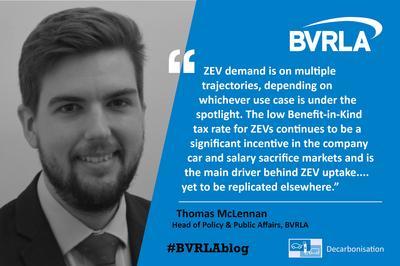Following the launch of the association’s 2023 Road to Zero Report Card, Thomas McLennan, Head of Policy and Public Affairs at the BVRLA looks at the UK’s appetite for Zero Emission Vehicles (ZEV). It’s a mixed picture, with rocketing improvements in business leasing demand but challenges in other sectors, especially rental.

The results of the Report Card show that ZEV demand is on multiple trajectories, depending on whichever use case is under the spotlight.
The low Benefit-in-Kind (BiK) tax rate for ZEVs continues to be a significant incentive in the company car and salary sacrifice markets and is the main driver behind ZEV uptake. Our Road to Zero Report shows that the success BiK unleashed in the company car segment is yet to be replicated elsewhere.
While the overall size of BVRLA members’ leasing fleets has increased across all fuel types, the growth in ZEV numbers has significantly outperformed ICE vehicles. Vehicles obtained through salary sacrifice schemes have also continued to increase significantly, with ZEVs representing 92% of new additions to the fleet last year.
ZEVs made up 19% of new additions in personal leasing, which is greater than the UK-wide figure of 16% in 2022. However, the proportion of personal leasing queries for ZEVs has decreased for the first time in Q1 2023, underscoring the tangible effects of the prevailing economic conditions and negative media coverage.
Looking at the rental sector, consumers are showing lower interest in ZEV short-term rentals compared to ICE counterparts. The sector is sensitive to customer demand so the proportion of ZEVs in the overall UK rental fleet remains small. ZEVs currently account for 4% of the total short-term rental fleet for cars and 0.6% for vans.
The primary causes of low consumer demand are cost and ease of use. Rental customers are unwilling to pay more for a product that is seen as more difficult for them to use. More needs to be done to help the rental sector transition to ZEVs across all vehicle types.
Across all segments demand for ZEV commercials is struggling. Most worryingly is the van market where early enthusiasm is being dampened by the realities of electric van operation. High costs, poor range and lack of appropriate infrastructure is causing a slow down in demand across channels.
Increasing electricity prices in 2022-23 have impacted the cost of EV charging, with public charging prices being particularly affected. In contrast the traditional fuels of petrol and diesel have fallen to pre-2022 prices.
There remains a considerable difference in the cost of charging at home compared to at a public chargepoint. Charging at an ultra-rapid chargepoint can be over 30% more expensive than fuel, while private home charging is around 35% cheaper than petrol and diesel on a pence per mile basis. Home charging can be even cheaper if off-peak tariffs are taken advantage of. As ZEV roll-out reaches the mass market, public charging will be more relied on, so it is vital to keep prices competitive.
In the Report Card, concerns over battery health are highlighted as affecting consumer confidence. Despite the lengthy warranties offered by OEMs, there is still considerable consumer anxiety about long-term battery health and reliability. A new range of battery status tests and certificates are emerging, but a lack of any harmonised industry standards is likely to limit their impact in supporting stronger used ZEV prices.
A key issue for many fleets has been the sharp fall in the price of used electric cars across 2023, with the depreciation rate well above ICE vehicles. In late 2022 and into 2023, trends in the used vehicle market for ZEVs have been driven by significant growth in supply that is outpacing demand. New ZEVs that entered the leasing sector in large numbers a few years ago are now finding their way into the used vehicle market at a level that is not being met by an equal uptick in demand.
The picture for the remainder of 2023 is mixed, with some experts believing that prices are likely to plateau while others expect prices to fall further. What is generally agreed is that there will continue to be increases in used ZEV stock and so there will need to be a corresponding increase in demand if prices are to stabilise. New market offerings that make second-hand ZEVs available under salary and personal contract hire schemes are a significant development that should help to drive demand.
A benefit to customers is that price parity between used ZEVs and ICE is edging closer. The catch is that used ZEV affordability being achieved through steep depreciation will make new vehicles more expensive to finance. Getting the balance between new and used demand right will be a key factor going into 2024, while price parity being achieved in both markets will see ZEVs higher and higher on company and driver wish lists.





